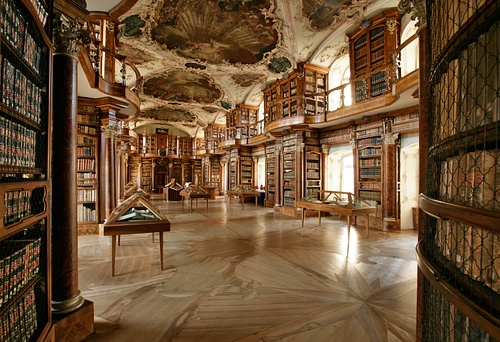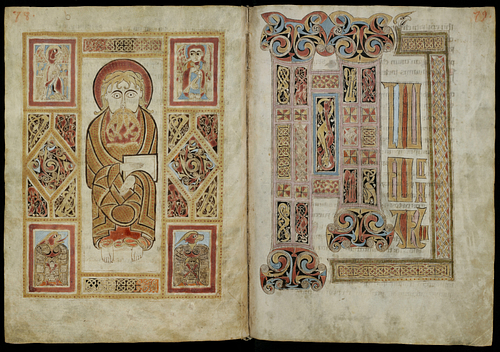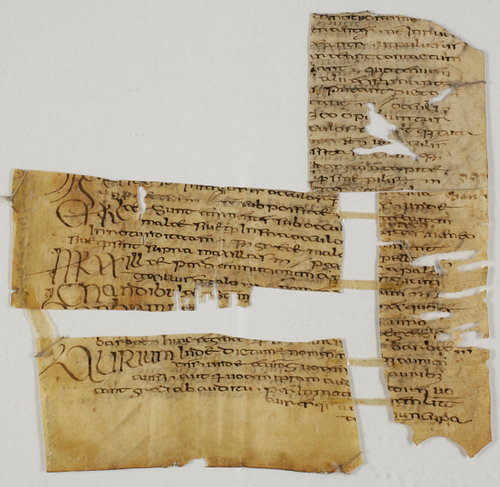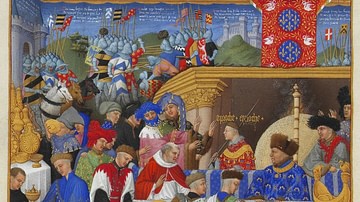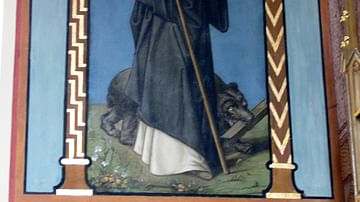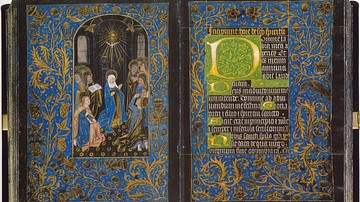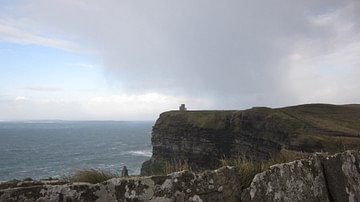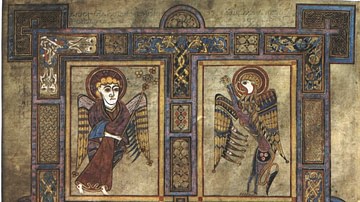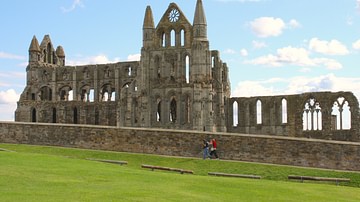Early medieval Irish book art is both beautiful and fascinating. It reflects a flourishing monastic culture which played a key role in the cultural development of Europe from the 6th to 9th centuries CE. Nowhere is this more clearly illustrated than at the Abbey of St. Gallen, in St. Gallen, Switzerland, which was founded by the Irish monk Saint Gall in 612 CE. In this exclusive interview with Dr. Cornel Dora, the Deputy Librarian at the Abbey Library St. Gallen, James Blake Wiener learns about a new exhibition that sheds light on the early medieval Irish contributions to European culture: The Cradle of European Culture: Early Medieval Irish Book Art.
JBW: Dr. Cornel Dora, thank you for speaking to me on behalf of Ancient History Encyclopedia (AHE) with regard to an exhibition at the Abbey St. Gallen Library in St. Gallen, Switzerland on early medieval Irish book art - The Cradle of European Culture: Early Medieval Irish Book Art - which runs until December 9, 2018.
It is worth noting that the Abbey Library houses the most beautiful collection of early medieval Irish manuscripts in continental Europe. For our readers who are not familiar with the history or importance of the Abbey St. Gallen, could you please explain why the abbey and its library have a special relationship with Ireland?
CD: St. Gallen was founded by the Irish monks Gall, a follower of Columbanus of Luxeuil, in 612 CE, and always kept a sense for its Irish roots. We know of several Irish guests in the monastery in the early medieval period and at least one gift of Irish manuscripts around the middle of the 9th century CE.
JBW: When many think of Ireland in relation to the European continent and subsequent European cultural development over history, they might be inclined to believe that Ireland was rather peripheral, never playing a pivotal role in European history. Why do so few people know about the early medieval Irish missions to Europe and the contributions of Irish monks to early medieval European art and culture in your opinion, Dr. Dora?
CD: The Irish share a similar fate to the Armenians. It was an extremely strong and vigorous Christian culture up to the 9th century CE, that later became victim to war, slaughter, and destruction. In the course of this, almost the whole great early Christian patrimony on the island was lost over the centuries.
JBW: When visiting The Cradle of European Culture: Early Medieval Irish Book Art, I was struck by the fact that it was an Irish monk who first wrote about Europe in a continental sense: St. Columbanus. Could you tell us a little bit more about St. Columbanus as well as the context in which he mentioned “Europe” in a letter to Pope Gregory the Great in the 6th century CE?
CD: Columbanus was a very dynamic figure who brought a new direction to monasticism in Gaul at the time of Pope Gregory the Great (c. 600 CE). He took part in some of the controversies of his time and discussed matters like discipline or the definition of the date of Easter, and he was conscious of his own originality, calling himself a "rare dove“ in another letter. In the opening address to his only letter to Gregory, dated around 600 CE, he calls him the "flower of Europe in its decay." For Columbanus, Ireland was like Rome, part of the European continent, and this continent was of Christian identity with the Pope as a leading figure. This is indeed the earliest written testimony of Europe with the character it is viewed until today in the European Union.
JBW: From c. 400-1000 CE, Irish missionaries spread Christianity, bringing monastery schools to modern Scotland, England, France, the Netherlands, Germany, and Switzerland. In doing so, they also transmitted a new, effervescent style of art throughout western Europe: Insular art.
Your exhibition showcases several examples of this vibrant artistic style, including the Irish Gospels of Saint Gall, which is an illuminated manuscript most likely produced in Ireland during the 8th century CE. In your own words, what is it about Irish art from this period that continues to fascinate and beguile us? How can we measure its importance in early medieval European art?
CD: These images with ornaments and human figures are moving, and they become very interesting when we consider the discussion about the use of pictures in different cultures and times. Images have something magical and directly emotional about them. These are meditational pictures that seek to guide the viewer towards a religious essence. In this, they are distant cousins of the icons of the Eastern Orthodox Church.
JBW: Dr. Dora, how did the Irish contribute to the seven liberal arts in the Early Middle Ages? Why was it so important to emphasize this within The Cradle of European Culture: Early Medieval Irish Book Art?
CD: From the 5th to the 9th centuries CE, the Irish were known as excellent scholars, and they contributed dynamically to the development of scholarship. In the exhibition, we make three examples: the lore of time, law, and biblical philology. It is absolutely stunning, what Irish scholarship was able to do 1200 years ago. Flying can be used as a metaphor for scholarship and faith for humanity, and the Irish, in that sense, knew to fly and they taught the continent to fly.
JBW: Of the items on display within the exhibition, do you have a favorite item or perhaps one that you find especially fascinating? If so, which piece and why?
CD: My personal favorite is the little Isidor fragment from the middle of the 7th century CE, in which we can show, how the Irish introduced capital letters at the beginnings of paragraphs, the separation of words from each other, and interpunction into writing; all innovations we still use every day.
JBW: I am always curious to know which challenges librarians and curators face when planning exhibitions, and yours is no exception, Dr. Dora. What challenges did you face in its organization? Additionally, what do you hope visitors take away from the exhibition after seeing it?
CD: We are very experienced in producing our exhibitions in which we draw on our own funds only. The biggest challenge is to bring the feeling of past to the present. Why were the people from the 5th to the 9th centuries CE so fascinated by Irish monks and scholars? I decided to explain it with the image of flying and the introduction of ideals. This is very basic when we try to understand the medieval period.
The years from 500 to 1500 CE – especially the first half – were the period of a vigorous Christian idealism that was basically driven by the ideas of Plato and St. Augustine. The shadows on the wall, as Plato called them, are more important than the visible world. Form these shadows and the word of God in the Bible, the medieval world perceived that every human being having an identity and equal ethical obligations. In this sense, the Middle Ages become indeed a period of flying.
JBW: Dr. Dora, I thank you so much for sharing your knowledge with us and for helping organize a splendid exhibition. I wish you many happy adventures in research!
CD: Thank you also, James.
Dr. Cornel Dora was born in 1963 in St. Gallen, Switzerland. He studied English, history, and musicology at the University of Zurich, graduating with a doctorate degree in history, and then continued to study as a librarian. From 1993 to 2001, Dr. Dora worked in the Abbey Library of St. Gallen and from 2001 to 2013, he directed the Cantonal Library Vadiana in St. Gallen, Switzerland. In 2012, he earned an Executive Master's degree in General Business Administration from the Executive School of the University of St. Gallen. Since November 1, 2013, he is a member of the Stiftsbibliothek of St.Gallen. His scientific interests lie in cultural and church history, as well as in book and library science. Dr. Cornel Dora is active in various scientific and library committees, including the Business Committee of the Wolfenbüttel Working Group for Library, Book and Media History, the Editorial Board of Codices electronice Confoederationis Helveticae (CeCH), the Board of the Association for the Swiss German Dictionary, the World Heritage Member Stiftsbezirk St. Gallen, and in the Scientific Advisory Board of Campus Galli, Carolingian monastery city. He is also a member of the Bavarian Benedictine Academy, and he is on the Board of Directors of SBD Library Service AG in Bern, Switzerland.
